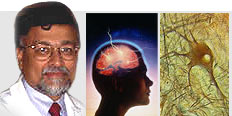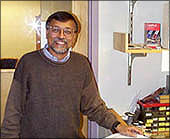The Rediff US Special/ Ela Dutt, India Abroad
He Listens to the Brain's 'Sur'

Mriganka Sur (47), head of the department of brain and cognitive sciences at the Massachusetts Institute of Technology, believes neuroscience has come of age and calls his lab (popularly called Sur Lab) a "fun place".
That's where students work seriously round the clock studying the brain.
"I definitely believe this is the age of neuroscience -- an age of tremendous advances, that will exponentially expand our understanding of the brain," says Sur, who was born in Fatehpur, Uttar Pradesh.
His lab's newest findings show how the brain adapts to new stimuli while maintaining a fixed number of cells. Described in the May 3 issue of Nature, Sur and his student Valentine Dragoi's work also helps explain optical illusions.
It turns out that some neurons in the primary visual cortex are quick-change artists. Neurons located in certain places have the ability to take on the function of neighbouring cells and then switch back to their own jobs for a brief time.
"For a long time it was thought that the visual cortex (part of the
cerebral cortex of the brain used for vision) was not changeable, and our work shows cells here are very changeable. It demonstrates the enormous adaptive capacity of the brain," Sur says, adding that this has "deep connotations for understanding the structure and function of the adult brain". This work is funded by the National Institutes of Health and by a Merck fellowship.
This newfound ability of certain neurons explains the visual phenomenon called the tilt after-effect. After staring at a set of tilted lines, when you look at a vertical line, it seems tilted in the opposite direction. No one knew whether this and other optical illusions were caused by the eye or the brain.
Sur, Dragoi and co-author Casto Rivadulla, previously a visiting scientist at MIT and now in Spain, demonstrate that in this case, the neurons responsible for recognizing line segments that lean one way have briefly taken over the job of neighbouring neurons that recognize line segments that lean the other way.
"This is the first time that anyone in this field has been able to show how local differences in the way the map of cells that make up the brain is constituted has consequences for how the brain works," Sur says.
Sur, who is also Sherman Fairchild professor of neuroscience at MIT, was brought up in Allahabad where he finished his secondary schooling at St Joseph's High School. He always wanted to work on the brain, but in some ways his future was decided in the ninth grade, he says, and he ended up in engineering.
"In India you get tracked so early into fields that my studies were of physics, chemistry and math, but I was very interested in biology. I did it on my own." When at IIT Kanpur, there was no biology; he kept studying the biological phenomena of the brain on his own. And when he applied for graduate work, he applied where there was a biology content in the engineering programme, at Vanderbilt University, Nashville, Tennessee.
"All my degrees are in engineering, but all the questions lie in biology. And engineering helped ask these questions," Sur says.
His PhD set him on the road to neuroscience. He worked on the sense of touch and got as his adviser a neuroscientist.
"There are many engineering principles you can use to study the brain," Sur says. "I tried to use communications theory to study how the spike trains of brain cells encode information. There are 10 billion cells in the brain and all of them send out electrical impulses. By recording the activity of brain cells, you can actually understand a lot of how the brain works. I worked on a piece of brain that deals with the sense of touch."
Subsequently, Sur got a post-doctoral fellowship at the State University of New York, Stony Brook (80-83). He became assistant professor thereafter at the Yale School of Medicine (83-86).

|
|
Mriganka Sur in his lab
| |
Then he joined MIT as Associate Professor and headed the Sur Lab; he subsequently became a Professor and then Fairchild Professor and was named department head of Brain and Cognitive Sciences in 1997. He divides his time between being department head and working at the lab.
"In the lab I have to deal with a lot of things -- framing and defining experiments, raising money, writing papers and articles, reviewing papers. Neuroscience at MIT is a rapidly expanding area."
Within the next few years, he expects to add eight new positions to his department alone.
Sur, who likes to travel and is "concerned about social justice in a deeply divided world", says his lab gets about $750,000 to $1 million in funding annually, primarily from the NIH.
Sur points out that the cells in our brain keep declining with age, in fact, right from birth. "One of the issues in brain function and understanding the brain is how does the brain continuously adapt to new things, or learn or remember. We know what makes the brain so special is its interconnections -- cells may be static in number, but not in functions. Each brain cell makes synapses with other cells and each has on it in turn 1000-10,000 synapses. Our work examines the effectiveness of these connections in the visual cortex -- how they impart plasticity to brain function... which underlies mental function."
Focusing on the development, plasticity and function of the cerebral cortex of the brain, Sur's lab studies many different aspects of these topics. "One of our more interesting projects involves rewiring the brain in order to understand what is unique about different areas of the cortex and how we might repair brain damage one day," he says.
Last year, the lab made another finding about plasticity in the developing brain in early childhood through experimenting with young animals.
"In those experiments, we routed the fibres from the eye that normally go to visual structures of the brain to the hearing regions in the brain. Then we asked what does vision do to the development of networks in the hearing or auditory cortex. This is a fundamental question, especially when it comes to repairing brain damage. What kinds of networks and connections develop in the hearing cortex that now receives input from the eyes? We discovered that vision transformed the hearing cortex so that the cortex was able to see."
While neuroscience always seemed a very complex science, Sur says, one can always only answer questions in a field when certain tools are developed. "And this is the time when other tools are available for studying the brain -- molecular tools from biology and genetics, functional magnetic resonance imaging recording the activity of single cells, tools of cell biology, and so on. All of this makes possible the advanced study of brain cells and of the working brain."
Now he is moving on to trying to find out genes that may be regulated by activity in the brain and the ways in which higher brain areas process information.
Sur is married to Abha, a historian of science who is active in the
Alliance for a Secular and Democratic South Asia in Boston. They have a son Samir (17).
YOU MAY ALSO LIKE TO SEE:
A new kind of vision
Back to top
Tell us what you think of this feature